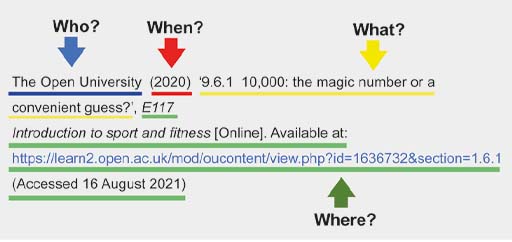2 Using direct quotes
As explained in the previous sessions of this course, direct quotes are where you use exactly the same words as the original author. If you feel that you need to directly quote any of the original source material to support your arguments, you must ensure that you put quotation marks around the entire directly quoted phrase, so that your words can be differentiated from the words of the original author.
For example, to include the opening sentence of this section in another resource, you would use quotation marks, as shown in the next sentence.
“As explained in the previous sessions of this course, direct quotes are where you use exactly the same words as the original author.”
As shown in the example above, you must remember to reference the direct quote, so keep a note of all the source and author details. If you do use direct quotes, keep them short and succinct. Ideally, you will rarely make use of direct quotes; quotes do not offer any of your interpretation or understanding of the material. It can be useful to ask yourself whether the quote you are thinking about using really does ‘add’ to your arguments or if you are just avoiding using your own words. Be honest with yourself.

If you do decide a quote is essential, as soon as you copy/paste (or retype it, word for word), add appropriate quotation marks and an in-text reference immediately. That way you won’t accidentally forget to identify the material as not being your own words.
Activity 1
The following extract is from ‘E117 Introduction to sport and fitness’, an introductory Open University module. For context, this extract was part of a section exploring physical activity.
Read the extract and then try to paraphrase it. Once done, click on the reveal button for discussion.
“In the UK, the number of steps taken by the average adult each day is between 3000 and 4000 (NHS, 2014). This is far lower than the commonly cited target of 10,000 steps. The guidance for 10,000 steps per day originated from Japanese walking clubs and a business slogan in the 1970s. It is not underpinned by any rigorous research, so it is important that we question why 10,000 steps is now seen as the standard target. Could the recent expansion of wearable technology have had an influence, perhaps? Is it simply a more easily remembered figure than 3000 or 4000, which is the average number of steps taken by adults each day? This is not to say, however, that 3000–4000 steps is sufficient. 10,000 steps appears to be a reasonable target for daily activity for apparently healthy adults, but is potentially too high for those with chronic diseases and older adults and too low for children?”
Discussion
For me, the key words/phrases were the target of 10,000 steps, the point that most people do not achieve them, and that the target was not derived from scientific studies.
Here was my attempt at paraphrasing. You’ll see it is significantly shorter, but retains the same meaning overall:
The average adult in the UK achieves around one third of the daily target of 10,000 steps per day, according to NHS sources cited in (The Open University, 2020). However, this target is open to question; it may not be appropriate for all age groups, nor those with chronic disease. Furthermore, it was not derived from scientific studies, rather it derives from a Japanese business slogan in the 1970s.
Reference: The Open University (2020) ‘9.6.1 10,000: the magic number or a convenient guess?’, E117 Introduction to sport and fitness [Online]. Available at: https://learn2.open.ac.uk/mod/oucontent/view.php?id=1636732§ion=1.6.1 (Accessed 16 August 2021) [Link only available to registered E117 students].
Can you identify the ‘who’, ‘what’, ‘when’ and ‘where’ elements of the reference given in the discussion above?

